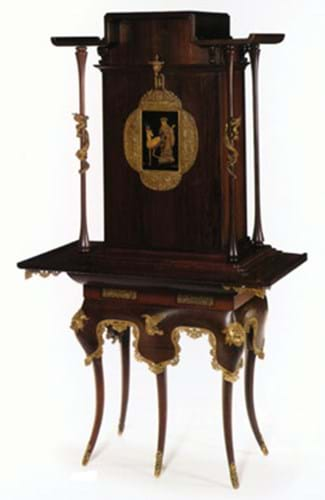
However, the price achieved attracted the attentions of the French government who questioned the legitimacy of the sale of a major French work of art from a French consignor on English soil.
At least seven of these cabinets, all slight stylistic variants, are thought to have been made to an original design by Edouard Lièvre (1829-1886).
Its first incarnation was a version dated 1877 set with an oil painting by Edouard Detaille and now in the Musée d'Orsay, Paris.
It formed the most celebrated element of a fabulous suite of neo-Japanese furniture designed by Lièvre for the director of the Bordeaux ceramics factory, Albert Vieillard (1841-1895).
Bonhams' cabinet - set with a Meiji lacquer plaque depicting Juroujin, god of longevity - was made almost two decades later by the luxury store Escalier de Cristal.
George and Henry Pannier, the merchant owners of Cristal who specialised in the so-called Sino-Japanese style, had attended the workshop sales of Lièvre's sketches and plans held posthumously in 1887 and 1890. Alongside other designs, they had acquired the technical drawings for this cabinet together with reproduction rights.
It is thanks to the archives of the Pannier brothers that we know that a further six cabinets were made.
The craftsmen were Kroeller (who executed the woodwork) and Pestat (the bronze mounts). The clients were Monsieurs Sieber, Magnier, David, Gizycki, Galoppe and the Grand Duc Wladimir.
Quite which cabinet was made for which client is unclear although an example in the Hermitage Museum in St. Petersburg (set with a watercolour by George Clairin) was in the Anitchkov Palace by 1897 and is probably that made for the Grand Duc Wladimir.
Another appeared for sale quite recently at German auctioneers Lempertz in May 2006 where, estimated at just €12,000-15,000, it sold for €750,000.
Bonhams' cabinet which was offered on December 4 had been consigned from a French collection.
The Russian connection that encouraged Bonhams to have the extensive catalogue notes translated into Cyrillic, proved important to the bidding. Just an hour prior to the sale a French-based Russian bidder booked a telephone line and proceeded to lock horns with another telephone bidder, understood to be calling from Russia.
The £300,000-500,000 estimate was left behind as François Le Brun, head of Bonhams' Continental furniture department, accepted bids at the rostrum to £1.8m.
Le Brun described the moment as "a once-in-a-lifetime sale which goes to the heart of the magic of auctioneering".
But such a big number (it rose to £2,036,000 when the buyer's premium was added) drew the attentions of the French government and it was only after a nervous week that Bonhams could announce a sale that ranks 19th century furniture alongside the best ancien regime cabinetmaking.
Two factors are understood to have encouraged the French authorities to drop their interest: the Musée d'Orsay already held the 1877 original and did not wish to purchase another and the piece was acquired by a French buyer and will again return to France.
By Roland Arkell




